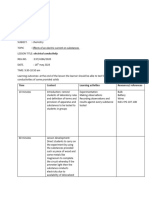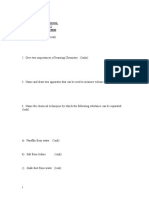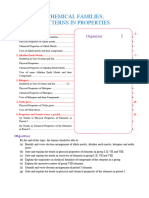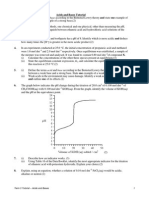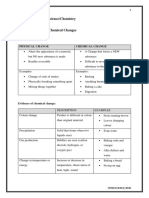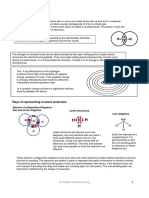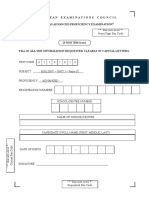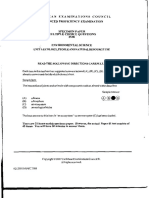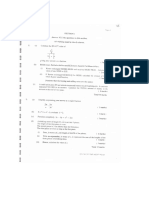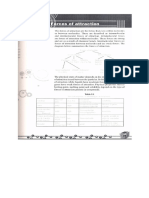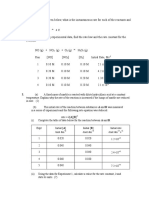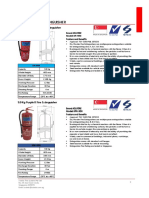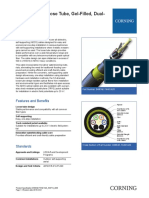Structure and Bonding Study Guide
Uploaded by
KelseyStructure and Bonding Study Guide
Uploaded by
KelseyStates of matter and forces of attraction
Learning outcomes
States of matter and melting point
On completion of this section, you
should be able to:
Substances with high melting points have strong forces of attraction
between their atoms (or ions). Substances with low melting points have
weak forces of attraction between their molecules.
understand the relationship
between forces of attraction and
states of matter
know that single covalent bonds
are formed by sharing a pair of
electrons between the atoms
understand covalent bonding in
terms of overlap of atomic
orbitals
xxxystrong
attractive
forces
weakforces
between molecules
dl'Loll'""'' '...
J
strong bonding
withinmolecules
Figure 2. 1. 1 The strength of forces and arrangement of particles in solids, liquids and gases
understand sigma and pi
bonding.
Giant structures with ionic or covalent bonds are solids
with high melting points: It takes a lot of energy to
break the many strong forces between the particles.
solidwith a
giant structure
Particles are in fixed arrangement
They only vibrate.
and do not move.
Molecular solids have low melting points: The forces
within the molecules are strong. But the forces between
the molecules are fairly weak so it does not take much
energy to overcome these.
molecularsolid
Particles are in fixed arrangement
not move. They only vibrate.
close together and do
Liquids have low melting points. The forces within the
molecules are strong. But the forces between the
molecules are weak so it does not take much energy to
overcome these.
liquid
attractive forcesbetween the
electronsof one atom and
the protons of another
Particles are close together but are more or less
randomly arranged. They slide over each other.
::0 : 1/\
\\ :::::.
::0
O~
O~
Gases have very low melting points and boiling points.
The forces between the molecules are very weak so it
does not take much energy to overcome these.
\\"'- <,
-===0 Particles
are far apart and move randomly.
gas
Figure 2.1.2
a The formation of a covalent bond
H-H
->
H ;H
electron pair
in covalent bond
b Two ways of showing the covalent bond
in hydrogen
Covalent bonding
A covalent bond is formed by the force of attraction between the nuclei
of two neighbouring atoms and a pair of electrons between them. The
attractive forces are in balance with the repulsive forces between the
electron clouds when the nuclei are a certain distance apart. Covalent
bonds arc usually strong. It needs a lot of energy to break them.
Chapter 2 Structure and bonding
Sigma bonds and pi bonds
Didyou know?
A covalent bond is formed when atomic orbitals (Section 1.4) overlap.
Each orbital which combines contributes one unpaired electron to the
bond. The 'joined' orbital is called a molecular orbital. The greater the
overlap of the atomic orbitals, the stronger is the covalent bond.
The combining power of an atom
is called its vaLency (from the
Latin valentia - meaning powerful).
So covalent means 'the power
of (atoms) joining together'. The
concept of valency is based on how
many hydrogen atoms combine
together with a given atom, e.g. the
valency of oxygen is two because
one oxygen can combine with two
hydrogen atoms in water.
Sigma bonds (a bonds)
Sigma bonds (a bonds) are formed by the overlap of atomic orbitals along
a line drawn between the two nuclei. The electron density of the bond
formed is symmetrical about a line joining the two nuclei.
nucleus
~}8-G
s atomic
orbitals
molecular orbital
Figure 2.1.3 Two s-type atomic orbitals overlap to form a molecular orbital
When a p orbital combines with an s orbital, the molecular orbital is
modified to include some s and some p character. The p orbital becomes
slightly altered in shape so that, on combining to form a molecular
orbital, one of the 'lobes' of the hour-glass shape becomes smaller. A
similar thing happens when two p orbitals combine 'end-on'. In each case
a a bond is formed.
molecular orbital
~
modified P
orbital
s orbital
a bond
molecular orbital
/
li1 Exam
tips
Although a rt bond has two areas
of electron density, you must
remember that these two areas
of electron density represent only
one bond. Do not confuse it with a
double bond, which contains one a
bond and one rt bond.
Key
points
modified P
modified P
a bond
orbital
orbital
Figure 2.1.4 The formation of sigma bonds by 'end-on' overlap of atomic orbitals
Solids with high melting points
have strong forces of attraction
between their atoms or ions.
Pi bonds (n bonds)
Pi bonds (n bonds) are formed by the sideways overlap of p atomic
orbitals. The electron density of the bond formed is not symmetrical
about a line joining the two nuclei. Figure 2.1.5 shows 2 p atomic orbitals
overlapping to form a n bond (see also Section 2.9).
Liquids and gases have low
melting points because of the
weak forces between their
molecules.
A covalent bond is formed by
the force of attraction between
the nuclei of two atoms and the
pair of electrons which forms the
bond.
Sigma bonds are formed by 'endon' overlap of atomic orbitals.
Pi bonds are formed by 'sideways'
overlap of atomic orbitals.
\Tt!
~J )J
p, orbital
-,
VJ
(
Jy~bO"d
,-~0
P, orbital
Figure 2. 1.5 The formation of a pi bond by 'sideways' overlap of pz atomic orbitals
Covalent bonding - dot and cross diagrams
Learning outcomes
SimpLe dot and cross diagrams
On completion of this section, you
should be able to:
A shared pair of electrons in a single bond is represented by a single line.
r>, r">. rT~
know that a single covalent bond
is formed when two atoms share
a pair of electrons
,-----
draw dot and cross diagrams for
electron deficient compounds
and compounds with an
expanded octet of electrons.
F)
~_.._
draw dot and cross diagrams for
a variety of compounds with
single bonds only
+ \
fluorine
,,--J
~ --
atoms
(:)
a shared pair
of electrons is a
covalent
,,_-.._5(*/.
fluorine
bond
F-F
molecule
Figure 2.2.1 The electron pairs in a fluorine molecule
It is usually only the outer electrons which are used in covalent bonding.
Electron pairs in the outer shell which are not used in bonding are called
lone pairs.
Dot and cross diagrams can be used to show the arrangement of outer
shell electrons in covalently bonded molecules. The main points are:
II'J
III
Example: Methane
Use a dot to represent the outer shell electrons from one atom and a
cross to represent the outer shell electrons from another atom.
Draw the outer electrons in pairs to emphasise the number of bond
pairs and the number of lone pairs. It also reflects the fact that each
orbital contains a maximum of two pairs of electrons.
If possible, electrons are arranged so that each atom has four pairs of
electrons around it (an octet of electrons/ the noble gas electron
configuration). Hydrogen is an exception - it can only have two
electrons around its nucleus when forming covalent bonds.
When pairing electrons, a covalent bond is formed between an
electron from one atom (dot) and an electron from another atom
(cross).
Figure 2.2.2 Drawing a dot and cross
diagram for methane
ExampLes of dot and cross diagrams
a
Didyou know?
@+G)-e
hydrogen
chloride
When we draw dot and cross
diagrams, there is no difference in
the electrons within each electron
pair. The dots and crosses are just a
book-keeping exercise to keep track
of the electrons. The electron density
in lone pairs of electrons is, however,
greater than that of bonding pairs of
electrons. For more information see
Section 2.8.
"\J
~
ammonia,
NH3
-(the
0
from a metal
atom when it
\~
hydroxide
extra electron,
comes
c:
ion
forms an ion)
Figure 2.2.3 Dot and cross diagrams for: a hydrogen chloride; b water; c ammonia; d the
hydroxide ion
Note that we can draw dot and cross structures for ions such as OH- and
NH4 + by applying the same rules. The square brackets around the ion
show that the charge is spread evenly over the ion.
Chapter 2 Structure and bonding.
Electron deficient
moLecuLes
Some molecules are unable to complete the octet of electrons when they
form covalent bonds. These molecules are said to be electron deficient.
An example is boron trichloride, BC13. This only has six electrons around
the boron atom.
Figure 2.2.4 Dot and cross diagrams for boron trichloride, Bet]
MoLecuLes with an expanded octet
Some molecules can increase the number of electrons in their outer shell
to more than 8. These molecules are said to have an expanded octet of
electrons. An example is sulphur hexafluoride, SF6. This has 12 electrons
around the sulphur atom.
Figure 2.2.5 Dot and cross diagrams for sulphur hexafluoride, SF6
Key points
A single covalent bond is formed when two atoms share a pair of electrons.
When atoms form covalent bonds each atom usually has a full outer shell
of electrons.
Electron deficient atoms in a compound have fewer than 8 electrons in
their outer shell.
Atoms with an expanded octet have more than 8 electrons in their outer
shell.
Dot and cross diagrams show how the electrons pair together in a
molecule or ion.
Exam tips
It is a common error to try and write
dot and cross diagrams for ionic
compounds as if they were covalent
molecules. If you have a compound
of a metal and non-metal then it is
likely to be ionic unless the metal
ion is very small and highly charged
compared with the non-metal ion.
To see how to write dot and cross
diagrams for ionic compounds see
Section 2.4.
More dot and cross diagrams
Learning outcomes
Molecules with multiple bonds
On completion of this section, you
should be able to:
Some atoms form bonds by sharing two pairs of electrons. A double bond is
formed. The double bond is shown by a double line, e.g. for oxygen, 0=0.
construct dot and cross diagrams
for molecules with double and
triple bonds
describe co-ordinate bonding
(dative covalent bonding)
two oxygen atoms
construct dot and cross diagrams
involving co-ordinate bonds.
oxygen molecule
0=0
2C~}O2 0 atoms
( atom
carbon dioxide
0=(=0
c
4
+0-
4 H atoms
ethene
2 C atoms
Figure 2.3.1 Dot and cross diagrams for: a oxygen; b carbon dioxide; c ethene
When atoms share three pairs of electrons, a triple bond is formed.
The triple bond is shown by a triple line, e.g. for nitrogen N=N.
Figure 2.3.2 A dot and cross diagram for nitrogen
Co-ordinate bonding
A co-ordinate bond (dative covalent bond) is formed when one atom
provides both the electrons for the covalent bond. For co-ordinate
bonding to occur we need:
one atom with a lone pair of electrons
a second atom with an unfilled orbital.
The atom with the unfilled orbital (an electron deficient atom) accepts
the lone pair of electrons to complete the outer shell of both atoms.
Example 1: Ammonium ion, NH4 +
t
1+
(;j+[r-Q
(H\
~../
Figure 2.3.3 A dot and cross diagram for an ammonium ion, NH 4 +
Chapter 2 Structure and bonding
In this example:
The H+ ion has space for two more electrons in its outer shell.
The nitrogen atom has a lone pair of electrons.
The lone pair on the nitrogen provides both electrons for the bond.
Each atom now has a noble gas electron configuration.
(H = 2; N = 2, 8).
The displayed formula (formula showing all atoms and bonds) shows the
co-ordinate bond as an ~. The head of the ~ points away from the atom
which donates the lone pair.
Example 2: Compound
Figure 2.3.4 The displayed formula for an
ammonium ion, NH/
formed between BF3 and NH3
Figure 2.3.5 A dot and cross diagram for the co-ordination compound, BF3NH3
In this example:
B has the simple electronic configuration 2, 6 when bonded to three
fluorine atoms. There is still room for 2 more electrons to be added to
its outer shell to form the nearest noble gas configuration.
N has a lone pair of electrons.
The nitrogen donates its lone pair to the unfilled orbital of boron.
Both boron and nitrogen have the simple electronic configuration 2, 8.
Example 3: Aluminium
chloride, AlCl3
Aluminium chloride is an electron deficient molecule - the aluminium
atom is 2 electrons short of the 8 electrons required for the nearest noble
gas configuration.
At room temperature, aluminium chloride exists as Al2Cl6 molecules.
This is because the lone pairs of electrons on two of the chlorine atoms
can form co-ordinate bonds with the aluminium atoms.
Figure 2.3.6 A dot and cross diagram for the AlzCi6 molecule
Key points
A double bond contains two pairs of electrons and a triple bond contains
three pairs of electrons.
Inco-ordinate (dative covalent) bonding one atom provides both electrons
for the bond.
Didyou know?
Hydrated aluminium chloride,
AICl36HzOis an ionic compound,
but anhydrous aluminium chloride is
a molecule with the formula AlzCl6
which has co-ordinate bonding
between two of the Cl and Al
atoms. The hydrated compound is
ionic because the water molecules
stabilise the A13+
ions. They do this by
co-ordinate bonding between water
molecules and the highly charged
A13+
ion.
Ionic and metallic bonding
Learning outcomes
The formation
On completion of this section, you
should be able to:
III
When electrons are transferred from metal atoms to non-metal atoms,
ions are formed.
III
The outer shell of both ions formed have the noble gas electron
configuration:
K
~
K+ + e:
0 + 2e- ~ 022, 8, 8,1
[2,8,8J+
2,6
[2,8)2-
III
Positive ions are formed by loss of electrons and negative ions are
formed by gain of electrons.
&I
In an ionic compound the number of positive and negative charges
must balance, e.g. for calcium chloride the ions present are Ca2+and
Cl. So the formula for calcium chloride is [Ca2+J2[Cl-], or more
simply, CaC12.
know that ions are formed when
atoms gain or lose electrons
write dot and cross diagrams for
ionic structures
describe the structure of metals.
~
1
Exam tips
Remember that for metal atoms
in Groups I to Ill, the charge
on the ion formed is the same
as the group number. For nonmetal atoms in Groups V to VII,
the charge on the ion is group
number -8. For example, 5 forms
the sulphide ion, 52- (6 - 8 = -2).
Remember that some positive
ions do not contain metals,
e.g. H+ and NH/ ions.
of ionic compounds
Dot and cross diagrams for ionic structures
When writing dot and cross diagrams for ionic structures we usually
show only the outer electron shells because these are the ones involved in
electron transfer. Figure 2.4.1 shows how to construct a dot and cross
diagram for magnesium oxide. Note:
11
The ions formed have a full outer shell of electrons (electron
configuration of the nearest noble gas).
IiI
The charge on the ion is placed at the top right.
III
The square brackets indicate that the charge is spread throughout the
ion.
2,8,2
2,6
[2,8]2+
[2,BF-
Figure 2.4.7 Constructing a dot and cross diagram for magnesium oxide
b
[NoT"
[2,8J
[NaJ
[2,8,8]2+
~
(2,BF-
[2,8]+
[2,8,8]-
Figure 2.4.2 Dot and cross diagrams for: a calcium chloride; b sodium oxide
Chapter 2 Structure and bonding
Ionic bonding
I
.
I
.
The ionic bond is an electrostatic force of attraction between oppositely
charged ions. The net attractive forces between these ions results in the
formation of a giant ionic structure. In this structure the ions are
regularly arranged in a three-dimensional lattice (see also Section 2.6).
The electrostatic attractive forces between the ions act in all directions
and the bonding is very strong .
0-
Metallic bonding
Most metals exist in a lattice of ions surrounded a 'sea' of delocalised
electrons. Delocalised electrons are those which are not associated with
any particular atom or ion. They are free to move between the metal
ions.
Figure 2.4.3 Part of a giant ionic lattice
of sodium chloride
outer electrons of metal become delocalised
..
,..-- .. ,
.
." ..
,.--"',
f'
'--"
..
...
:+~:+::+::+:
..
'"
-"'...
..
.. --"',-
I'
..'" -"..
...
..
..
,'.',
..
"
' ..
....
:+::+::+::+::+:
',--,'
,\,--,'
...
',--,'
"
"
"
:, + ,:
.'--"
..
.' + : " + : .' + : " + :
"
strong ionic bonds
between oppositely
charged ions
"
....
',--,'
..
',--,'
'sea' of delocalised electrons
Figure 2.4.4 The structure of a typical metal. (Note: the diagram shows only one layer of
atoms for clarity. In reality there would be other layers on top of and beneath the layer
shown.)
In this structure:
The positive charges are held together by their strong electrostatic
attraction to the delocalised electrons.
[ill'
This strong electrostatic attraction acts in all directions.
So metallic bonding is usually strong.
Remember that the big difference
between metallic and ionic bonding
is:
I
I
I
The number of delocalised electrons depends on the number of
electrons lost by each metal atom.
11
The strength of metallic bonding increases with:
increasing positive charge on the ions
decreasing size of the metal ions
increasing number of delocalised electrons.
I
I
I
Key points
Ions are formed when atoms gain or lose electrons.
Ions generally have a full outer shell of electrons (noble gas structure).
Ionic bonding is the net attractive force between positively and negatively
charged ions.
Metallic bonding is a lattice of positive ions in a 'sea' of delocalised
electrons.
Exam tips
Ionic: the negative charges are ions.
M~taLlic: the negative charges are
electrons.
ELectronegativity and intermoLecuLar forces
Learning outcomes
Electronegativity
On completion of this section, you
should be able to:
Electronegativity is the ability of a particular atom involved in covalent
bond formation to attract the bonding pair of electrons to itself.
Electronegativity increases across a period from Group I to Group VII.
Electronegativity decreases down any group.
The order of electronegativity is: F > 0 > N > Cl > Br. .. > C > H.
understand the meaning of the
terms 'electronegativity' and
'bond polarity'
describe the three types of weak
intermolecular forces: permanent
dipole-dipole, van der Waals,
hydrogen bonding.
b
r:--:~
centre of ion charge the same
centre of
+ charge
Polarity in molecules: bond polarisation
If the electronegativity values of the two atoms in a covalent bond are
the same, we say that the bond is non-polar.
If the electronegativity values of the two atoms in a covalent bond are
different, we say that the bond is polar.
We can also apply the idea of polarity to molecules:
f
centre of
- charge
Figure 2.5. 1 a Hydrogen is a non-polar
molecule because the centres of + and
- charge coincide. b Hydrogen fluoride is
polar because the centres of + andcharge do not coincide.
In a non-polar molecule the centres of positive and negative charge
coincide.
In a polar molecule the centres of positive and negative charge do not
coincide. This means that one end of the molecule is slightly negatively
charged, (5-, and the other end is slightly positively charged, (5+.
The degree of polarity is measured by a dipole moment. This is shown by
the sign -1---7. The ~ points to the partially negatively charged end of the
molecule.
Examples:
(5+ (5-1---7
H-Cl
(5-
(5+
~
Cl- Br
If we kn.ow the shape of a molecule and the polarity of each bond, we can
tell if the molecule as a whole is polar or non-polar. If the polarities of the
bonds act so that they oppose each other, they may cancel each other out.
The molecule is then non-polar (see Figure 2.5.2) because the centre of
positive and negative charge is the same.
a
Exam tips
We often talk about bonding in
general terms as being strong or
weak. Many chemists however
reserve the term 'bonding' for
stronger bonding, especially covalent
bonding. When we are talking about
weak bonding between molecules,
it is more accurate to refer to them
as forces between molecules. It
may help to make the distinction
between forces within molecules
(strong bonding) and forces between
molecules (weak).
dipoles add so
molecule polar
dipoles add so
molecule polar
dipoles cancel
each other so
molecule non-polar
Figure 2.5.2 The polarity in: a water; b trichloromethane; c tetra chloromethane
Weak intermolecular
forces
Intermolecular forces arise because of the attraction between the dipoles
in neighbouring molecules. There are three types of intermolecular force:
permanent dipole-dipole forces
van der Waals forces
hydrogen bonding.
Chapter 2 Structure and bonding
Intermolecular forces are weak compared with covalent, ionic and
metallic bonding. The comparative strength of these intermolecular
forces are generally in the order: hydrogen bonding> permanent dipoledipole> van der Waals.
Permanent dipole-dipole
CH3-,.
forces
,8+
Permanent dipole-dipole forces are the weak attractive forces between
the 8+ of the dipole of one molecule and the 8- of the dipole of a
neighbouring molecule (see Figure 2.5.3).
CH3
f>-
C= 0
"8+
11111111111111111111
CH3/
8-
C= 0
CH3/
Figure 2.5.3 Permanent dipole-dipole
forces between two propanone molecules
van der Waals forces
van der Waals forces of attraction are not permanent. All atoms and
molecules, including noble gas atoms, have van der Waals forces.
Electrons in atom.s are always in motion.
So the electron density may be greater in one part of the molecule
than another.
So an instantaneous dipole is formed.
This dipole can induce the formation of a dipole in a neighbouring
molecule.
The two neighbouring molecules attract each other because of their
dipoles.
electron density greater
here temporarily
g.,
Didyou know?
The peculiar properties of water,
e.g. lower density of ice than water
and high surface tension, are due to
more extensive hydrogen bonding
than in many other molecules. Water
molecules have two hydrogen atoms
and two lone pairs of electrons. So
water can form an average of two
hydrogen bonds per molecule.
temporary attraction
between 0+and 0-
single atom
Figure 2.5.4 van der Waals forces are only temporary because the electrons in the
molecules of atoms are in constant movement
Hydrogen bonding
Hydrogen bonding is a special form of permanent dipole bonding. It
requires:
one molecule with an H atom covalently bonded to an F, 0 or N
atom. These are the most electronegative atoms
a second molecule having a ~ 0 or N atom with a lone pair of
electrons.
a
8+
O-H---:O
8+ /
Electronegativity is the ability of
an atom in a covalent bond to
attract electrons in the bond to
itself.
Electronegativity differences
together with the structure
of molecules can be used to
determine whether a molecule is
polar or non-polar.
van der Waals forces are based on
temporarily induced dipoles.
Hydrogen bonding occurs
between molecules having a lone
pair of electrons on F,0 or Nand
a hydrogen atom attached by a
covalent bond to F,Oor N.
8+
f>-/H
8+\
H-band shown by
3 dashes or 3 dots
~-..
Key points
..
<,
f>-..
8+
:O-H---:N-
8+
8+ /
8-,/
8+
"8+
lone pair
Figure 2.5.5 Hydrogen bonding: a in pure water; b between water and ammonia
molecules
Properties of giant structures
Learning outcomes
lattices
On completion of this section, you
should be able to:
A lattice is a regular three-dimensional arrangement of particles. Lattice
with strong bonding between the particles are called giant structures.
The three types of giant structures are:
describe giant structures in terms
of their lattices
11
giant ionic, e.g. sodium chloride, magnesium oxide (see Section 2.4
for diagram)
understand how the properties of
giant ionic structures, giant
covalent structures and metals
are related to their structure.
11
giant covalent (sometimes called giant molecular), e.g. diamond,
silicon dioxide
1\1
metallic, e.g. copper, iron (see Section 2.4 for diagram).
Properties of giant ionic structures
III
Melting and boiling points are high: it takes a lot of energy to break
the large number of strong bonds between the oppositely charged ion!
(see Section 2.4).
11
Soluble in water: the ions can form ion-dipole bonds with water
molecules.
Figure 2.6.7 Water molecules forming ion-dipole bonds around + and - ions
Conduct electricity only when molten or dissolved in water: the ions
can only move when molten or dissolved in water. They cannot move
in the solid.
!II
solid
Sfu&0-~
"th~d~H?~n~e ~
cathode
~~
--c:!) -
+
anode
Figure 2.6.2 a The ions cannot move in the solid state. b The ions are free to move in the
liquid state.
11
Exam tips
A common error in exams is to
suggest that electrons are involved
when substances such as molten
sodium chloride conduct electricity.
First ask yourself if the structure
is ionic (compound of reactive
metal with non metal). If it is ionic,
remember the 'ion' in ionic.
Brittle: when a force is applied, the layers of ions slide. When many
ions of the same charge are next to each other, there are many
repulsive forces. So the lattice breaks easily.
a
Figure 2. 6.3 a A small force is applied. b The ions move out of position and ions with the
same charge are next to each other so the lattice breaks along this plane.
Chapter 2 Structure and bonding
Properties of giant covalent
structures
Melting and boiling points are high: it takes a lot of energy to break
the large number of strong covalent bonds in the network of atoms.
b
..
silicon atom
weak forces ~
between ~~
layers
~ .
~
Figure 2.6.4 The structures 0[- a diamond; b graphite; c silicon dioxide
Insoluble in water: the atoms are too strongly bonded to form bonds
with water.
Apart from graphite they do not conduct electricity: there are no
electrons or ions that are free to move. Graphite conducts because it
has some delocalised electrons. These electrons move anywhere along
the layers when a voltage is applied.
l!l
Apart from graphite they are hard: the three-dimensional network of
strong bonds in different directions is too difficult to break. Graphite
is soft because there are weak van der Waals forces between the layers.
So the layers can slide over each other when a force is applied.
Didyou know?
Each carbon atom in graphite is
bonded to three others. This leaves a
'spare' electron in a p orbital in each
carbon atom. These electrons form a
huge delocalised system around all
the rings in the graphite structure by
re bonding. So the graphite conducts
along the layers, but not between
the layers.
Properties of metals
Melting and boiling points are high: it takes a lot of energy to break
the large number of strong forces of attraction between the ions and
the delocalised electrons (see Section 2.4).
Insoluble in water (although some react with water): the force of
attraction between the ions and the delocalised electrons is too strong
to form bonds with water. Some metals react with water because they
lose electrons.
Conduct electricity when solid or molten: the delocalised electrons are
free to move when a voltage is applied.
Malleable (can be beaten into shape) and ductile (can be drawn into
wires): when a force is applied, the layers of metal ions can slide over
each other. The attractive forces between the metal ions and the
electrons can still act in all directions. So when the layers slide, new
bonds can easily form. This leaves the metal in a different shape but
still strong.
Key points
Giant ionic structures have a
regularly repeating lattice of ions.
Giant structures have high
melting and boiling points
because they have many strong
bonds in many directions.
Giant ionic structures are
generally soluble in water. They
only conduct electricity when
molten or dissolved in water
because the ions are free to
move.
Metals conduct electricity
because some of the electrons
are free to move throughout the
structure.
Giant covalent structures do
not conduct electricity because
they do not have free moving
electrons or ions.
Metallic structures are malleable
and ductile becausethe layers of
atoms can slide over each other.
Figure 2.6.5 a A small force is applied to a metal. b The metal ions slide out of position,
but there are still strong forces between the ions and the delocalised electrons.
Properties of simple molecular compounds
Learning outcomes
Molecular
On completion of this section, you
should be able to:
Substances with a simple molecular structure such as iodine, 12, can form
crystals. This reflects a regular packing of the molecules in a lattice. The
forces between the molecules are the weak van der Waals forces. So,
simple molecular structures which are solids at room temperature are
brittle. They do not conduct electricity because they have neither
delocalised electrons nor ions.
understand how the properties of
simple molecular compounds are
related to their structures
know that simple molecular
solids often have a lattice
structure
understand how hydrogen
bonding influences the properties
of molecules
describe the solubility of
molecular compounds in polar
and non-polar solvents.
lattices
Figure 2. 7. 7 The lattice structure of iodine (only shown in two dimensions)
Melting and boiling points of simple molecular
structures
Many simple molecular substances are liquids or gases. They have low
melting and boiling points because it does not take much energy to
overcome the weak intermolecular forces between the molecules. Solids
with molecular lattices, such as iodine or sulphur, are also easily broken
down when heated. It does not take much energy to overcome the weak
van der Waals forces keeping the lattice together.
van der Waals forces increase with:
/CHl"
/CHl"
CH3
CHl
CH3
/CHl"
CH3
/CHl".
CHl
CH3
Figure 2.7.2 2,2-dimethylpropane,
a has
a lower boiling point than pentane; b
because there are more contact points for
van der Waals forces to act over
III
increasing number of electrons in the molecule
increasing number of contact points in the molecule (contact points
are places where the molecules come close together).
So the melting points and boiling points of the noble gases and the
halogens increase down each group as the number of electrons (and the
relative mass) increases.
Pentane and 2,2-dimethylpropane have the same number of electrons,
but the boiling point of pentane is higher. This is because there are more
contact points for van der Waals forces to act over. The total van der
Waals forces per molecule are therefore greater. So the boiling point is
higher.
Large molecules, such as straight chained polymers, are solids at room
temperature because they have very high relative molecular masses (large
number of electrons). Also there are many contact points for the van der
Waals forces to act over.
Chapter 2 Structure and bonding
The anomalous properties of water
Ii1 Exam
Water has a much higher boiling point than expected by comparison with
other Group VI hydrides. The boiling points of the hydrides from H2S to
H2Teincrease gradually due to increased van der Waals forces. Water has
a much higher boiling point than the other hydrides because it is
extensively hydrogen-bonded. Since hydrogen-bonding is stronger
compared with other intermolecular forces, it takes a lot more energy to
vaporise water than the other Group VI hydrides.
400
g300
....
c
.~ 200
O<J
tips
It is not always safe to assume
that compounds with hydrogen
bonding or dipole-dipole bonding
always have a higher boiling point
than those with van der Waals
intermolecular forces. For example,
the boiling point of SbH3 (not
H-bonded) is higher than that of
NH3 (H-bonded). This is because we
are comparing molecules with very
different masses, SbH3 being more
than 10x the mass of NH3.
.2
100
Figure 2.7.3 The boiling
points of the Group VI
hydrides
0+------.------,------.------,--
period
Most solids are denser than their corresponding liquids. Ice, however, is
less dense than (liquid) water. This is because the molecules in ice are
arranged in an 'open' lattice structure stabilised by hydrogen bonding.
The molecules are not as close together as in liquid water.
Water also has a high surface tension due to hydrogen bonding.
Solubility of simple molecular substances
In order to dissolve, the strength of the attractive forces between solute
and solvent is usually greater than between the solute molecules
themselves. Most covalently-bonded molecules such as iodine, sulphur
and butane, are insoluble in water. Many are non-polar and so water
molecules are not attracted to them. They will, however, dissolve in
non-polar solvents such as hexane if the new intermolecular forces
formed between the solvent and solute are stronger than those between
the solute molecules themselves. Some simple molecules are soluble in
water, e.g. ethanol, C2HsOH and ammonia, NH3. This is because they
can form hydrogen bonds with water.
0+
13+
H
0-..
0+
0-/'
:O-H---:N-H
0+ /
"
0+
8-/
:O-H---:O
0-..
8+ /
ClHS
0+
.. "
0+
Figure 2.7.5 Hydrogen bonding between: a ammonia and water; b ethanol and water
Key poin ts
Simple molecular solids can form lattices with weak forces between the
molecules.
Simple molecular solids have low melting and boiling points because there
are weak forces between the molecules.
Hydrogen-bonded molecules have relatively higher melting and boiling
points than expected and many are soluble in water.
The total van der Waals forces between molecules may determine the state
of a simple molecular compound at room temperature.
Figure 2.7.4 The structure of ice
Didyou know?
You can float a needle on water
because of the strong hydrogen
bonding in the water. Place a needle
on a piece of filter paper. Put the
paper and needle on the surface
of some very still water. When the
filter paper sinks, the needle should
remain on the surface of the water.
Shapes of molecules (1)
Learning outcomes
VSEPR theory
On completion of this section, you
should be able to:
The valence shell electron pair repulsion theory (VSEPR theory) can be
used to work out the shapes of molecules. It uses the following rules:
Pairs of electrons in the outer shells of the atoms in a molecule repel
each other and move as far apart as possible. This minimises
repulsive forces in the molecule.
predict the shapes and bond
angles in simple molecules and
ions.
Repulsion between
than the repulsion
Repulsion between
than the repulsion
III
lone-pairs and lone-pairs (of electrons) is greater
between lone-pairs and bond-pairs of electrons.
lone-pairs and bond-pairs (of electrons) is greater
between bond-pairs and bond-pairs of electrons.
Shapes of moLecuLes with onLy singLe bonds
The information below shows how VSEPR theory is used to work out the
shapes of various molecules.
b
Four bond pairs. No lone pairs around C.
Equal repulsion. So bond angles all 109S.
Shape: tetrahedral.
(NH4 + ion is also this shape)
H
x.
H;C~H
.x
H
..
d
F
: F:
.x
B+.
.. ..
:F::F:
:ci;. Be;ci:
..
F
F...
greater repu
4..I
H;N~H
.x
H
'Octa-' means eight. So an
octahedron has eight faces.
m
..
:0:
H+ H
SI on
H/ L ~H
H less
repulsion
Three bond pairs. One lone pair around N.
.
Greater repulsion between lone and
bonding pairs. So bond angles close up to
107.
Shape: pyramidal.
Three bond pairs. One lone pair around o.
Greater repulsion between lone and bonding
pairs. So bond angles close up to l O?".
Shape: pyramidal. (The CH3 - ion also has
this shape.)
Two bond pairs. Two lone pairs around o.
Greatest repulsion between lone pairs, less
repulsion between lone pairs and bond pairs
medium and least repulsion between bonding pairs.
repulsion So bond angles close up to 104.5.
Shape: non-linear, V-shaped.
greatest
.~repulsion
0
H<>~
/ t
104.5
Figure 2.8.2 An octahedron
I.
C;~~J
k ~
Six bond pairs. No lone pairs around S.
Equal repulsion. So bond angles all 90.
Shape: octahedral.
1070
Figure 2.8.1 A tetrahedron
I .. F
F~I~~o
Remember that 'tetra-' means four.
So a tetrahedron has four faces.
Two bond pairs. No lone pairs around Be.
Equal repulsion. So bond angles both 180.
Shape: linear .
Cl-~-Cl
F
F .. x. F
~ S ~
F .x ..F
F
Exam tips
I
1800
Three bond pairs. No lone pairs around B.
Equal repulsion. So bond angles all 120.
Shape: trigonal planar.
1200
~F
least
repulsion
Chapter 2 Structure
Shapes of moLecuLes and compound
ions with
muLtipLe bonds
The information below shows how VSEPR theory is used to work out the
shapes of carbon dioxide as well as oxo ions (those containing oxygen and
another non-metal).
a
.. ..
l l2l..
..
~O:
000
d
:o:!o:
.. .
~O:
+ +.~2-
:O~SO:
x.
..
:0:
2-
Three groups of bond pairs. No
lone pairs. Equal repulsion. So
bond angles 120.
Shape: trigonal planar.
(The nitrate ion is also trigonal
planar.)
2-
Four groups of bond pairs. No
lone pairs. Equal repulsion. So
bond angles 109.5.
Shape: tetrahedral.
o
~200
.+
Two groups of two bonding pairs.
No lone pairs. Equal repulsion.
So bond angles both 180.
Shape: linear.
1800
:0;(;0:
1200 0
o
11
~+.'"
0_:-1 "'0
109.5 0
Key points
The shapes and bond angles in molecules can be predicted using VSEPR
theory which depends on the number of lone pairs and bonding pairs of
electrons around a particular atom.
In VSEPR theory. lone-pair: lone-pair repulsion>
repulsion>
bond-pair:
bond-pair repulsion.
lone-pair:
bond-pair
and bonding
Didyou know?
Experimental data shows that all
the carbon-oxygen
bond lengths in
(0/ions are the same. Similarly all
the sulphur-oxygen
bond lengths in
the SO/- ion are the same. This is
due to hybridisation of the orbitals .
Each bond has a bond length
between that of a double and single
bond between the relevant atoms.
Shapes of molecules (2)
Learning outcomes
Hybridisation of orbitaLs
On completion of this section, you
should be able to:
Methane has four C-H bonds of equal length. The four unfilled C atomic
orbitals can be thought of as being mixed so that each has {s character
and
character. This process of mixing atomic orbitals is called
hybridisation. These mixed orbitals are called Sp3orbitals. Hybridisation
allows a greater overlap of atomic orbitals when a molecular orbital is
formed and also allows each bond to be the same. They are all (J bonds
with equal repulsion between them.
predict the shapes and bond
angles in simple organic
compounds
understand the shapes of
molecules using the idea of
hybridisation of atomic orbitals
use ideas of hybridisation to
describe the shape of benzene.
tP
----~
ex::,---~ '
Sp3
orbital
from C
Is orbital
from H
C-H molecular
orbital
Figure 2. 9. 7 a An Sp3orbital from carbon combines with a Is orbital from H to form a
molecular orbital making up a C-H bond; b Methane has 4 directional hybrid orbitals
Other hydrocarbons with single bonds also form molecular orbitals from
hybridised Sp3orbitals.
r>. >er-bonds
(\. x . L-
~C:/}~--.'--\:)
o
\-
I.
Figure 2.9.2 The structure of ethane. The molecular orbitals formed from Sp3hybrids
allow each bond to be a ss-bond.
The structure of ethene
The dot and cross diagram and shape of ethene are shown below.
a
Figure 2.9.3 a Dot and cross diagram for ethene; b Shape of an ethene molecule
In ethene, one singly occupied 2s orbital and two of the three singly
occupied 2p orbitals in each carbon atom hybridise to make three Sp2
orbitals. These have similar shapes to Sp3orbitals. These sp- orbitals
form (J bonds which are arranged in a plane making a bond angle of
approximately 120 with each other since there is equal repulsion of the
electrons.
The remaining 2p orbitals from each carbon atom. overlap sideways to
form a rr. bond.
TI-bond
u-bonds
Figure 2.9.4 Ethene has three Sp2orbitals
in one plane and a ti-bond above and
below this plane
The H-C-H bond angle in ethene is 117.3, rather than the 120
expected, because of the influence of the re-bond whose. electron density is
at right angles to that of the plane of the carbon and hydrogen atoms,
This bond angle allows the maximum overlap of the orbitals.
Chapter 2 Structure and bonding
Resonance
In methane and ethene the electrons are localised, i.e. they are in
particular positions. In some substances, the molecular orbitals extend
over three or more atoms, allowing some of the electrons free movement
over these atoms. These electrons are said to be delocalised.
Benzene, C6H6, has six carbon atoms arranged in a ring. Figure 2.9.S(a)
shows a representation of benzene. The H means that the actual
structure is a single (composite) form which lies between these two
structures. The bonds between the carbon atoms are neither double nor
single bonds. They are somewhere in-between. The composite structure
is called a resonance hybrid.
a
0-0
_-
0
,r
,,
...
-'"
.
'
'"
Figure 2. 9.5 a Two possible ways of representing benzene; b A modem representation of
benzene
In benzene, the six carbon atoms form a hexagon with three localised Sp2
hybrid orbitals (one to each hydrogen atom and two to other carbon
atoms). The 3 Sp2orbitals are arranged in a plane. So the bond angles are
120. This leaves a single p orbital on each of the six carbon atoms.
These orbitals overlap sideways to form a delocalised system of re bonds.
The six electrons involved can move freely around the ring.
Figure 2.9.6 The structure of benzene: a The p orbitals before overlap (the Sp2hybrids are
shown by the straight lines); b The delocalised system of re bonds
In graphite, each carbon atom forms three localised Sp2hybrid orbitals to
the other carbon atoms. The remaining p orbitals overlap sideways on to
form an extensive system of delocalised electrons. These electrons can
move along the layers when a voltage is applied. This is why graphite
conducts electricity.
Key points
Hybridisation of sand p atomic orbitals results in the formation
orbital with mixed character.
of an
The shapes of simple organic molecules can be predicted using VSEPR
theory and the idea of hybridisation.
Benzene is a resonance hybrid with a planar ring.
[i1 Exam tips
It is a common error to think that
resonance hybrids are mixtures of
two or more forms of a structure.
They are single structures. We can
represent the 'in-between' structure
in many cases by the use of dashed
lines (see Figure 2.9.5(b))
b
2
Draw dot and cross diagrams for the following
molecules:
a HzS
b PCl3
C
3 a
b
4
Using the concept of atomic orbitals, explain
how:
sigma and
ii pi bonds are formed.
Which of these two bonds is stronger? Explain
your answer.
COz
How is a co-ordinate bond formed?
H30+ has a co-ordinate bond. Draw a dot and
cross diagram to show the bonding in this ion.
Use dot and cross diagrams to illustrate the bonding
in the following ionic compounds:
a potassium sulphide
b aluminium oxide
a
b
c
An element has one electron in its outer shell
and has filled inner shells. Describe the type of
bonding in this element.
Would the melting point of this element be
relatively high or low? Explain your answer.
Place the following Period 3 metals in order of
increasing melting point:
aluminium
a
b
c
sodium
magnesium
Define 'electronegativity'.
What is the trend in electronegativity
down Group VII?
Explain your answer to part (b).
as you go
Identify the following molecules as polar or nonpolar:
a BF3
b CH3Cl
C
COz
NH3
a
b
State the three types of intermolecular forces of
attraction.
Identify the type of intermolecular force of
attraction in the following molecules:
CO
ii
NH3
iii HF
iv ICl
9
Magnesium oxide, diamond and aluminium are
all solids. Using structure and bonding explain the
differences, if any, among these three solids in terms
of the following properties:
a melting point
b electrical conductivity
c solubility in water.
10 Using structure
a
b
c
and bonding explain why iodine:
is brittle
does not conduct electricity
iodine vaporises very easily.
11 Explain why water has a much higher boiling point
than the other Group VI hydrides.
12 Which of the following molecules would have a
higher melting point, BCl3or Pcl3? Explain your
answer.
13 Using VSEPR theory, state and explain the shapes of
the following molecules and ions:
a H30+
b HzS
C
BCl3
d
CCl4
PH3
You might also like
- Chemistry Lesson Plans: Electrolysis & Carbon AllotropesNo ratings yetChemistry Lesson Plans: Electrolysis & Carbon Allotropes14 pages
- Physics - Form - 2 - End - Term - 2 - Exams - 2024 - Set - 1-1809 (3) - 1No ratings yetPhysics - Form - 2 - End - Term - 2 - Exams - 2024 - Set - 1-1809 (3) - 112 pages
- FORM 3 CHLORINE AND ITS COMPOUNDS QUESTIONS Teacher - Co - .KeNo ratings yetFORM 3 CHLORINE AND ITS COMPOUNDS QUESTIONS Teacher - Co - .Ke3 pages
- Chemistry Term 1 YR 2020 CHEMISTRY FORM 1No ratings yetChemistry Term 1 YR 2020 CHEMISTRY FORM 15 pages
- Kcse 2024 Kapsabet, Kenya High & Maseno MockNo ratings yetKcse 2024 Kapsabet, Kenya High & Maseno Mock249 pages
- Chemistry PP3 QN Form 4 2022 End Term 1 Teacher - Co - .KeNo ratings yetChemistry PP3 QN Form 4 2022 End Term 1 Teacher - Co - .Ke7 pages
- Acids Bases and Indicators Chemistry Form 1 Topical Questions and Answers100% (1)Acids Bases and Indicators Chemistry Form 1 Topical Questions and Answers6 pages
- Carbon and Its Compounds Questions and AnswersNo ratings yetCarbon and Its Compounds Questions and Answers12 pages
- Form 3 All Subjects: Endterm 2 AssignmentNo ratings yetForm 3 All Subjects: Endterm 2 Assignment166 pages
- S2 Chemistry Notes Carbon and Its CompoundsNo ratings yetS2 Chemistry Notes Carbon and Its Compounds17 pages
- Group 4 Elementscarbon Silicon Germanium Tin and Lead100% (1)Group 4 Elementscarbon Silicon Germanium Tin and Lead22 pages
- Form 2 Chemistry Physical and Chemical Changes PDFNo ratings yetForm 2 Chemistry Physical and Chemical Changes PDF6 pages
- Covalent Bonding: Ways of Representing Covalent MoleculesNo ratings yetCovalent Bonding: Ways of Representing Covalent Molecules9 pages
- CAPE ENVIRONMENTAL SCIENCES Spec 08 U1 P1 MC55% (11)CAPE ENVIRONMENTAL SCIENCES Spec 08 U1 P1 MC7 pages
- CAPE ENVIRONMENTAL SCIENCES Spec 08 U1 P1 MC55% (11)CAPE ENVIRONMENTAL SCIENCES Spec 08 U1 P1 MC7 pages
- Secretory Vesicles Containing Mucilage Trans FaceNo ratings yetSecretory Vesicles Containing Mucilage Trans Face1 page
- Comparison of Parenchyma, Sclerenchyma and Collenchyma67% (3)Comparison of Parenchyma, Sclerenchyma and Collenchyma1 page
- CAPE Comunication Studies Characteristics of Standard vs. Creole100% (1)CAPE Comunication Studies Characteristics of Standard vs. Creole9 pages
- Bright Annealing Process of Stainless S Teel TubeNo ratings yetBright Annealing Process of Stainless S Teel Tube2 pages
- Catalouge Fiber Cement Roofing Sheets - Brazil - Part 2No ratings yetCatalouge Fiber Cement Roofing Sheets - Brazil - Part 25 pages
- 6 TOPIC 3 ESTIMATING Carpenter N SteelworksNo ratings yet6 TOPIC 3 ESTIMATING Carpenter N Steelworks37 pages
- Solo ADSS Loose Tube, Gel-Filled, Dual-Jacket Cable: 48 F, Single-Mode (OS2)No ratings yetSolo ADSS Loose Tube, Gel-Filled, Dual-Jacket Cable: 48 F, Single-Mode (OS2)4 pages
- Study On The Corrosive Nature of Soil Towards The Buried-StructuresNo ratings yetStudy On The Corrosive Nature of Soil Towards The Buried-Structures5 pages
- SCI 8 - Q3 - Lesson 1 Properties of Matter - For StudentsNo ratings yetSCI 8 - Q3 - Lesson 1 Properties of Matter - For Students21 pages
- ASTM 1598 - Standard Test Method For Time-to-Failure of Plastic Pipe Under Constant Internal PressureNo ratings yetASTM 1598 - Standard Test Method For Time-to-Failure of Plastic Pipe Under Constant Internal Pressure0 pages
- 20d-Stepped Masonry Retaining Wall-Stability Check100% (2)20d-Stepped Masonry Retaining Wall-Stability Check6 pages
- Oil&Gas Draka MOG 2015 Catalog v16 With Glands UpdatedeverythingNo ratings yetOil&Gas Draka MOG 2015 Catalog v16 With Glands Updatedeverything96 pages
- Davydov Splitting and Excitonic Resonance Effects in Raman Spectra of Few Layer MoSe2No ratings yetDavydov Splitting and Excitonic Resonance Effects in Raman Spectra of Few Layer MoSe28 pages
- MSDS Canada - ZRC-221 Cold Galvanizing CompoundNo ratings yetMSDS Canada - ZRC-221 Cold Galvanizing Compound7 pages
- EU-NORM Symposium 5-8 June 2012 Tallinn Estonia ProceedingsNo ratings yetEU-NORM Symposium 5-8 June 2012 Tallinn Estonia Proceedings210 pages
